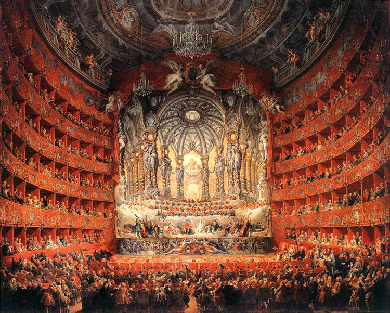1600-
If one relates musical periods to architecture, the Medieval period might
be symbolized by Notre Dame Cathedral in Paris, the Renaissance by the
Duomo in Florence, and the Baroque by Louis XIV's palace at
Versailles. Baroque music is often highly ornate, colorful and richly
textured when compared with its predecessors.
Opera was born at what is considered to be the very beginning of the
Baroque era, around 1600. This unique form combines poetry, theater,
the visual arts and music. It came about because a group of Italian
intellectuals wanted to recapture the spirit of ancient Greek drama in
which music played a key role. The first great opera was Orfeo, by
Claudio Monteverdi, first performed in 1607. Music's ability to express
human emotions and depict natural phenomenon was explored throughout
the Baroque period. Vivaldi's famous set of concertos, The Four
Seasons, is a famous example.
Although imitative polyphony remained fundamental to musical
composition, homophonic writing became increasingly important.
Homophonic music features a clear distinction between the melody line
and an subsidiary accompanimental part. This style was important in
opera and other solo vocal music because it focused the listener's
attention on the expressive melody of the singer.
The homophonic style gradually became prevalent in instrumental music
as well. Many Baroque works include a continuo part in which a
keyboard (harpsichord or organ) and bass instrument (cello or bassoon)
provide the harmonic underpinning of chords that accompanies the
melodic line(s).
New polyphonic forms were developed, and as in the Renaissance,
composers considered the art of counterpoint (the crafting of polyphony)
to be essential to their art. Canons and fugues, two very strict forms of
imitative polyphony, were extremely popular. Composers were even
expected to be able to improvise complex fugues on a moment's notice to
prove their skill.
The orchestra evolved during the early Baroque, starting as an
"accompanist" for operatic and vocal music. By the mid-
orchestra had a life of its own. The concerto was a favorite Baroque form
that featured a solo instrumentalist (or small ensemble of soloists) playing
"against" the orchestra, creating interesting contrasts of volume and
texture.
Many Baroque composers were also virtuoso performers. For example,
Archangelo Corelli was famous for his violin playing and Johann
Sebastian Bach was famous for his keyboard skills. The highly
ornamented quality of Baroque melody lent itself perfectly to such
displays of musical dexterity.
